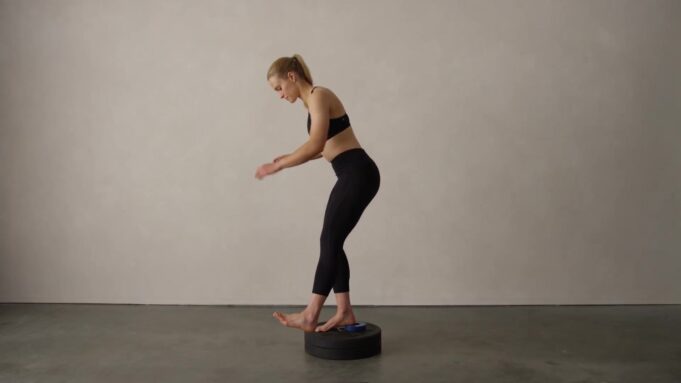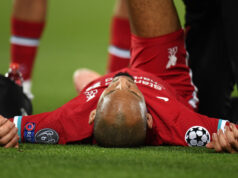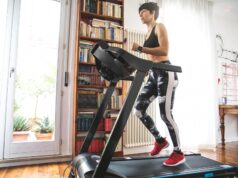Step aside, traditional squats and lunges! There’s a new leg-day hero in town. Introducing the Patrick Step – a power-packed exercise that’s quickly taking the fitness world by storm. From professional athletes to office workers looking for a mid-day boost, everyone’s stepping it up!
In this post, we’re diving into the muscles targeted by the Patrick Step. This is not just another exercise; it’s a full-blown, all-encompassing muscle extravaganza! Once you’re done reading, you’ll be well-equipped to integrate the Patrick Step into your workout regimen, unleashing your ultimate fitness potential.
We will explore the muscles from your legs to your upper body, all of which are engaged by this single move. Buckle up, as this is going to be an educational ride, which will if incorporated properly give you amazing results in no time!
Patrick Step
The Patrick Step has emerged as a game-changing exercise that offers a full-body workout, targeting multiple muscle groups and delivering impressive results. This dynamic exercise not only challenges your lower body strength but also engages various muscles throughout your entire body, making it a go-to exercise for those seeking a comprehensive workout.
Starting from the lower body, the quadriceps, or the front thigh muscles, play a vital role in the Patrick Step. As you lift your foot and step up, the quadriceps work tirelessly to extend your knee and provide the necessary power for upward propulsion. Through the repetitive motion and a wide range of movement involved in the Patrick Step, these muscles are pushed to their limits, resulting in stronger and more resilient quads.
Simultaneously, the hamstrings, located at the back of the thigh, act as stabilizers during the lowering phase of the Patrick Step. These muscles work in harmony with the quadriceps to control the descent and support the knee joint, leading to improved stability and toned hamstrings.
Moreover, the Patrick Step goes beyond just the lower body, engaging muscles in the upper body as well. The deltoids, biceps, and triceps in the arms are actively involved, contributing to improved upper body strength and toning. Additionally, the trapezius muscles in the upper back and neck play a vital role in maintaining proper posture and shoulder stability during the exercise.
So, let’s start!
Quadriceps

The quadriceps, often referred to as the quads, are a group of four muscles in the front of the thigh. They are the vastus lateralis, vastus medialis, vastus intermedius, and rectus femoris. These muscles are critical in actions such as walking, running, and jumping.
As you lift your foot and step up in the Patrick Step, your quadriceps work overtime. They are primarily responsible for extending your knee and providing the power needed to propel your body upward. The Patrick Step challenges these muscles due to the repetitive motion and range involved, which ultimately leads to stronger quads.
Hamstrings
Let’s talk about our hams. The hamstrings are the three muscles at the back of your thigh: biceps femoris, semitendinosus, and semimembranosus. They are responsible for bending your knee and extending your hip.
When performing the Patrick Step, as you lower your body back to the ground, your hamstrings act as stabilizers. They control the descent and support the knee joint, working in tandem with the quadriceps. This control and stabilization help in toning and strengthening the hamstrings.
Glutes
Off to the glutes! These muscles, comprising the gluteus maximus, medius, and minimus, are situated in the buttocks. They play a crucial role in hip extension, outward rotation, and stabilization of the hip joint.
As you push your body upwards in the Patrick Step, your glutes are called into action. They work to extend the hip and stabilize your pelvis. This repeated engagement helps in building stronger and more toned gluteal muscles.
Calves
Your calf muscles, primarily the gastrocnemius and soleus, are located at the back of the lower leg. They are vital for plantar flexion – the action of pointing your toes or pushing off the ground during walking or running.
When you start stepping up, your calf muscles help to lift your heel off the ground, allowing you to balance on your toes. This forces the calves to work against gravity, helping to strengthen and define them.
Core Muscles

The core muscles include the rectus abdominis, obliques, and erector spinae. These muscles are essential for maintaining stability, balance, and supporting the spine.
In the Patrick Step, maintaining balance is key. Your core muscles work tirelessly to keep your torso upright and stable. This engagement not only strengthens the core but also improves your overall balance and posture.
Hip Flexors
What we have next are the hip flexors.These flexors are a group of muscles, including the iliopsoas and rectus femoris, that help you lift your knees towards your chest, or bend at the waist.
During the Patrick Step, as you lift your knee towards your chest, your hip flexors are engaged. This exercise helps to strengthen these muscles, which can lead to improved mobility and less chance of injury.
Adductors
The adductor muscles, located in your inner thighs, are responsible for pulling your legs together (adduction) and stabilizing the hip joint.
While performing the Patrick Step, your adductors assist in stabilizing your hips and legs, working hard to keep your body aligned. This provides an excellent workout for these often-overlooked muscles, helping them become stronger and more toned.
Abductors

Abductors, on the other hand, are located on the outer thigh and are responsible for moving your leg away from the midline of the body.
The Patrick Step also engages the abductors as they work to stabilize your hip and leg while stepping up and down. This exercise helps to tone and strengthen these muscles, enhancing your overall leg strength.
Deltoids
Move aside for the shoulder power. The deltoids are the shoulder muscles, crucial for the stability and movement of the shoulder joint. They are divided into three parts – anterior, lateral, and posterior deltoid.
When you start incorporating this exercise into your workout routine, the deltoids are actively engaged when you swing your arms for momentum. The repeated motion works to strengthen these muscles, providing you with stronger and more defined shoulders.
Biceps
Arms and Patrick step? That’s right! The biceps brachii, located in the upper arm, are responsible for elbow flexion and forearm supination (turning your palm upwards).
As you use your arms for balance and momentum during the Patrick Step, your biceps are activated. The dynamic motion of this exercise works these muscles, promoting better upper body strength.
Triceps
On the opposite side of the biceps, you find the triceps brachii, responsible for elbow extension.
Just like the biceps, the triceps are also engaged when you swing your arms in the Patrick Step. This full arm movement helps to tone and strengthen your triceps.
Trapezius

The trapezius muscle, or traps, located in your upper back and neck, plays a vital role in moving and stabilizing the shoulder blades.
During the Patrick Step, the movement of your arms and maintaining a straight posture engage the trapezius. This helps to strengthen these muscles, leading to improved posture and shoulder stability.
Conclusion
Today, we’ve taken a deep dive into the power of the Patrick Step. From the quadriceps to the trapezius, this single exercise targets and works an impressive range of muscles.
Including the Patrick Step in your routine can strengthen and tone various muscle groups, improving your overall fitness and physique. It’s not just a leg day exercise; it’s a full-body workout!
So, why wait? Incorporate the Patrick Step into your workouts, and start reaping the benefits today. Remember, every step you take brings you closer to your fitness goals.
Start your journey with the Patrick Step today, and step into a healthier, fitter future. Happy stepping!















